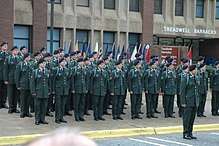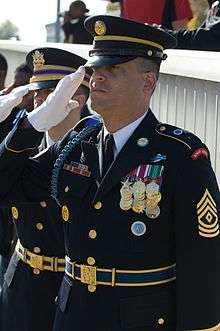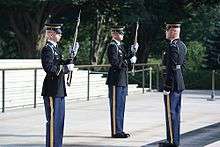Infantry Blue Cord




The Infantry Blue Cord is a United States Army decoration worn over the right shoulder of all qualified U.S. Army infantrymen. It is a fourragere in light blue ("Infantry Blue") worn under the right shoulder and under the right epaulette of a U.S. Army infantryman's Class A dress blue uniform jacket or Class B shirt. The cord is composed of a series of alternating left and right half knots that are tied around a leader cord to form a "Solomon bar".
The Infantry Blue Cord is presented to all qualified infantrymen in the U.S. Army at the end of their Advanced Individual Training. Commissioned officers earn their blue cord after graduating from the U.S. Army Infantry School's Infantry Officer Basic Course (IBOLC). Enlisted infantrymen earn their Blue Cords after successfully completing all Infantry Training Brigade requirements required for achieving the infantry MOS by graduating from 16 weeks of Infantry One Station Unit Training (OSUT), or six weeks of Infantry Advanced Individual Training (AIT) for those who go through "Basic" and AIT via Split Training Option (Split-Op) which is conducted at the 233rd Regional Training Institute at Camp Robinson in North Little Rock, Arkansas or the U.S. Army Infantry Center's Infantry Training Brigade at Fort Benning, Georgia.
The Infantry Blue Cord is authorized to be worn only by qualified U.S. Army Infantrymen currently assigned to an infantry unit in the Active Army, or Army National Guard. Only those with an Infantry MOS Military Occupational Specialty such as 11A (Infantry Officers), 11B, 11C, (NOT 11X as this is an "unassigned" position designated for recruits who are contracted into the CMF (Career Management Field) 11 - Infantry) may wear this cord. Other 11 series MOS holders (as both their primary and duty MOS) who may wear the cord are Infantrymen assigned to an Infantry slot that is not in an Infantry unit (such as with Infantry assigned to a cavalry unit) if authorized, or Instructors, Drill Sergeants, or Recruiters.
Qualified Infantry soldiers who are not assigned to an Infantry unit, to include those who are an 11-series MOS holder transitioning to 18-series MOS, for example, (CMF 18 is the designation for the Army Special Forces MOS) may not wear the Infantry Blue Cord or Disks. Those assigned to an Infantry unit may wear the Infantry Blue Cord and Disks until their transition to a non-Infantry unit is complete.
History
During the Korean War General "Lightning Joe" Collins, Chief of Staff for the Army, asked a group of advisers what could be done to enhance the morale of the fighting Infantryman. It was decided that they would receive special insignia, so that everyone would know that the soldier was an Infantryman who would be fighting on the front lines.
A light-blue cord was created to be worn on the right shoulder of both infantry trained officers and enlisted men. Also, light-blue plastic disks were issued to be placed behind the metal "crossed rifles" Infantry branch of service insignia U.S. collar discs o Class A and Class B uniforms as well as on the US Coat of Arms disc on the front of the service cap. The new enhancements were first worn by the 3rd US Infantry Regiment ("The Old Guard"). The light-blue cord and disks became standard for all Infantrymen in 1952.
Presentation
Today, enlisted graduates of infantry "One Station Unit Training" or "Split Training Option" receive their blue cord at the "Turning Blue" ceremony held the day before their graduation from Infantry advanced individual training (AIT). This ceremony typically follows a week-long field training exercise (FTX) including at least a 5-mile ruck march to the field, multiple force on force and team exercises that precede at least a 12-mile ruck march back to garrison. All other recruits first attend a 9-week basic combat training (BCT) course before moving on to their AIT in which they will have a similar ceremony. However, only those who have graduated the infantry school and maintain postings in infantry units OR certain branch immaterial units (i.e.: Drill Sergeant, Branch Detailed Recruiters, etc...) are authorized to wear the blue cord.
Graduates of the Infantry Basic Officer Leaders Course (formerly IOBC) must complete their two-week-long final FTX with a 16-mile tactical road march and a mock company attack. Prior to graduation and out-processing, students have their "Blue Cord" ceremony at Freedom Hall where their blue cords are pinned on them by their platoon trainer Captain and NCOs. The staff sergeant or sergeant first class who pins on the blue cord then renders a salute recognizing the lieutenant's entry into the ranks of the Infantry.
See also
References
- AR 670-1, Wear and Appearance of Army Uniforms and Insignia (28–30. Distinctive items authorized for infantry personnel).